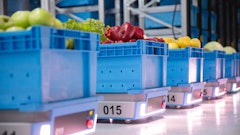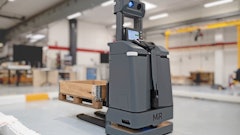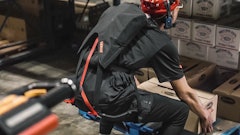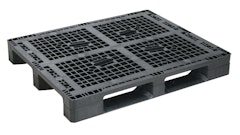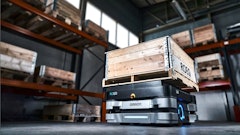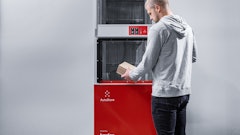
With the average order selector in a grocery distribution center picking some 30 tons of product a day, it’s no wonder distributors are having a hard time attracting and retaining warehouse labor—despite rising unemployment levels.
A growing number of grocery distributors are addressing this challenge by building automated or semi-automated facilities that significantly reduce manpower. These facilities use a variety of automated storage retrieval systems (AS/RS) including horizontal and vertical carousels, stacker cranes, conveying and sortation systems and automated guided vehicles.
“The key trends driving food industry automation ultimately stem from the rapidly increasing demand for fresh food among a growing majority of consumers who want to live healthier lives by avoiding additives and preservatives, says Burke McCarthy, director, marketing and system sales, Retrotech Inc., Fishers, NY.
“For purveyors of perishable goods like food and fashion, time is money. The faster the rate at which goods must travel, the better the case becomes for automated material handling systems,” says McCarthy.
Despite their hefty price tags, and the weak economy, companies are investing in AS/RS. Recent examples of grocers that have embraced automation include H.E. Butt Grocery Co., which is using an AS/RS to automatically store pallets of frozen goods and retrieve products for full pallet delivery in a new facility in San Antonio, TX and Sobey’s Inc., Canada’s second largest grocery retailer, which is building an automated distribution center in Ontario that will be using AS/RS pallet cranes and miniload cranes.
“We’ve found that the main driver for these companies to invest in automation is the cost of labor,” says Benny Rokni, senior consultant, food and beverage, HK Systems Inc., Milwaukee. “Competition is high and the labor pool is shrinking. Our customers are telling us that nobody wants to work any more. And if they’re in a cold storage environment, that’s even more physically demanding.”
ONGOING ISSUE: SKU PROLIFERATION
The proliferation of SKUs is also driving the trend, according to Brian Sherman, business development manager, Witron Integrated Logistics Corp., Arlington Heights, IL. “One of the biggest challenges facing U.S. retailers in the continual growth of item counts within the distribution center. To provide pick slots for this item count proliferation, in a manual pick environment, the retailer will have to expand the warehouse.”
Instead of expanding a manual pick operation, Sherman says companies should first investigate the return of investment (ROI) of the automated alternative. “An automated solution will likely eliminate the need to expand the building and focus on providing the picker only what needs to be picked at any given time—thus eliminating the permanent pick front.”
“We’re seeing a movement towards warehouse systems that accommodate slow moving inventory more effectively,” says Ken Ruehrdanz, market development manager, Dematic Corp., Grand Rapids, MI. “SKU proliferation has created the need for more pick faces, longer routes to travel and more requirements for storage space in the warehouse. AS/RS automation directly addresses this issue.”
Further compounding the SKU proliferation issue is the continuing merger and acquisition activity in food and beverage manufacturing and distribution. “SKU proliferation directly impacts your labor and productivity. Companies are merging and consolidating their networks and they’re rationalizing their various warehouses into one major distribution center,” says Rokni.
“Especially in the beverage industry, where they’re combining networks as well as territories and taking a couple of warehouses and combining them under one roof. They’re trying to service a larger territory from that one facility and increasing labor isn’t enough,” he adds.
Food and beverage manufacturers, as opposed to distributors, have more readily adapted AS/RS, and these companies continue to expand their use of these systems.
“While AS/RS implementations are still far from the norm, I have noticed that more food and beverage companies are investing in these solutions,” says Thompson Brockmann, project director for Tompkins Associates, Raleigh, NC.
“The quantitative aspects behind evaluating automated systems have not changed as food companies are looking for a solid return on their investment. In recent years, the AS/RS are offering stronger paybacks due to escalating land costs, construction prices, limited expansion room and higher inventory turns.
“This, combined with increased emphasis on many of the qualitative advantages, such as less dependence on a labor force and increased inventory accuracy, have driven this trend.”
Other factors, according to Ruehrdanz, include the need for “store friendly” order assembly. “We’re seeing warehouse systems that efficiently order select mixed case pallets. Retail stores prefer that pallets delivered to the store be stacked by family groupings and correlate to the store planogram—which speeds restocking and reduces store labor,” says Ruehrdanz. “Furthermore, food businesses that need to build pallets for route delivery require mixed case pallets. High capacity output AS/RS that can rapidly serve up the cases ‘in sequence’ for manual or automated palletizing are required for productive operation.”
Up until a few years ago, environmental factors played a small role in deciding whether or not go with an AS/RS. But an automated facility can significantly reduce energy costs, according to experts. “Energy savings range from 35 percent to 50 percent less with an automated warehouse,” says Ruehrdanz.
“More than 50 percent of the world’s carbon emissions are from the ‘built’ environment. Smaller, more dense warehouses that use less energy to light, heat, cool or freeze are more environmental,” he says.
“Because an automated warehouse features a high bay configuration, a smaller building footprint is required. The smaller building footprint is typically 30 percent of a traditional warehouse. And since the automated warehouse utilizes a high density configuration, less cubic space is required for the same amount of storage. This reduction is approximately 25 percent to 35 percent.”
Laura Walker, marketing manager, Westfalia Technologies Inc., York, PA, says that in refrigerated and frozen warehouses, her company’s clients have seen a 30 percent to 40 percent drop in energy costs alone.
“This is because AS/RS warehouses use less square footage to store the same amount of products as a conventional warehouse—up to 40 percent less square footage. We can go up in levels, up to 140 feet high for dense cubic storage.
Energy costs are higher for cooling than they are for heating, Ruehrdanz points out. “Most loss is from the roof—and a high-bay warehouse has a smaller roof surface.”
Brockmann adds that companies can reduce the access points into climate controlled areas and the time that access points are open. He also points out that AS/RS cranes designs are getting better at matching applications, resulting in smaller motors and some manufacturers, such as Westfalia and H.K. Systems, can even generate their own energy during shuttle descents.
“Our storage/retrieval systems have regenerative breaking, which feeds back the surplus brake energy to the power supply system,” says Westfalia’s Worker.
Worker also points out that since AS/RS systems reduce the need for lift trucks, there is less product and building damage, as well as less dirt and exhaust waste. Plus, there can be a reduction in the use of stretch wrap.
“Smooth handling by some of our solutions, including our Storage/Retrieval Machine, Satellite rack shuttle and conveyors—all with triple rail support available—translates into needing less stretch wrap,” she says. “A reduction in waste is another environmental benefit.”
AUTOMATION CAN BE FLEXIBLE
Flexibility has always been a concern for food companies, but vendors say that these systems are more flexible than most realize.
“Vendors continue to fine tune the crane designs such that they fit a variety of applications and can even provide flexibility into designs for business changes,” says Brockmann.
“During a recent AS/RS design phase in which the future load was expected to possibly double in size, we worked with the vendor to design the racking system so that the location sizes and aisle lengths could be easily increased, all while still meeting the throughput requirements,” says Brockmann.
“The flexibility was added to the design with minimal impact to the investment, but with considerable savings down the road if load sizes are impacted.”





